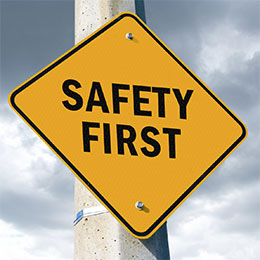 Being the boss has its perks, but anyone who has started a business also knows that the responsibilities that come along with being in charge can be overwhelming. To avoid problems down the road, business owners should take precautions at the early stages of their company’s development to ensure that reliable safety measures are in place. That is prudent advice regardless of the size or nature of your business. Although dealing with safety issues up front may require some initial expenses, careful planning can ultimately save you a great deal of money down the road.
Being the boss has its perks, but anyone who has started a business also knows that the responsibilities that come along with being in charge can be overwhelming. To avoid problems down the road, business owners should take precautions at the early stages of their company’s development to ensure that reliable safety measures are in place. That is prudent advice regardless of the size or nature of your business. Although dealing with safety issues up front may require some initial expenses, careful planning can ultimately save you a great deal of money down the road.
Creating an Employee Manual. Anyone who has employees should have an employee manual or handbook. Basic templates are available on the internet, but the best strategy is to consult an expert. Although you may decide to start with a template that you can acquire for little or no money, an attorney with employment law expertise can help you customize your manual to address the specific concerns associated with your business.
For example, if you have a retail establishment, a definitive policy on how employees deal with theft and onsite injuries must be included. Otherwise, you potentially leave your staff and yourself exposed to uncertainty and liability. Employees should also have written directives included in their employment agreement that explains procedures to follow in the event of an emergency. In addition, if anything about your business involves inherently dangerous conditions or materials (handling of chemicals or other hazardous materials, for example), employees should have written guidelines to promote safety.
Customize Your Employee Training. Despite the importance of formalizing your safety policies and procedures in writing, relying on employees to retain all the information is unrealistic. Instead, prudent employers will reinforce the written word with hands-on safety education. This sort of training should commence before you open your doors and should continue periodically to remind everyone of your expectations. You should start by studying the NEBOSH certificate requirements to ensure your employees are trained to the highest standards. In addition, these sessions should focus on the specific nature of your business and the kinds of safety issues that are most likely to arise in that environment. If hiring an expert to conduct safety training is not in your budget, consider researching information provided by entities like the Occupational and Safety Health Administration (OSHA). OSHA is a branch of the United States Department of Labor which is charged with setting and enforcing healthy and safe workplace standards throughout the country.
Establishing a Clear Chain of Command. Business owners should clearly establish how safety problems should be addressed in the workplace, and a clear chain of command is one step in the right direction. For example, each staff member needs to understand who he or she should contact if an accident occurs or if a potential safety issue arises. Regardless of whether all employees are instructed to report such issues to their direct supervisor, to the CEO, to a human resources representative, or to a designated safety specialist – communicating clear expectations for how safety concerns should be handled is imperative.
Make Sure Your Building is Sound. For brick and mortar establishments, employers must ensure that their building is structurally sound and that no conditions exist which would endanger employees, clients, or customers. Issuance of a certificate of occupancy or its equivalent by the relevant governmental entity should not be regarded as confirmation that no hidden problems exist. In fact, some jurisdictions have fairly low standards that have to be satisfied to pass inspection. Therefore, invest a little money in hiring a qualified, licensed, and insured building inspector to provide a thorough report on the condition of the premises.
Generally Promoting Health and Safety. If your staff recognizes that you are actively promoting a safe and healthy environment, chances are your employees will be more likely to voluntarily take proactive steps along those same lines. Without a doubt, healthy employees are more productive employees, so that policy benefits everyone.
Insure Yourself Adequately. Despite our best efforts, circumstances out of our control can lead to safety issues. If you’ve established a clear chain of command and adequately educated employees on how to react when problems arise, you are one step ahead. However, it’s also always a good idea to obtain appropriate insurance coverage based on the risks involved in your line of work. For example, virtually all business owners will need some sort of general liability insurance, and anyone with employees should obtain a workers’ compensation insurance policy.
Jay Acker leads a production team at safetyservicescompany.com. The company offers contractor verification assistance services along with a complete set of safety training materials.



